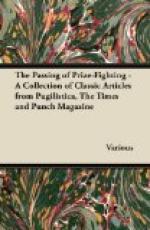The lark he trills his song on high,
A tiny speck on a wide blue sky;
“Tira-lir, it’s sweet up here,
It’s sweet up here, my dear, my
dear.”
The turtle-dove’s in love and so
Is anxious all his world should know
And follow his example too:—
“Look at us two. Oh do, oh
do.”
Woodpeckers make their thirsty cry
Of “Pluie, pluie, pluie,”
to a sunlit sky;
But sure enough they have their way
For rain, rain, rain will fall next day.
The blackbird also craves a boon,
Says “Bring a cherry, bring a cherry,
soon, soon, soon;”
And there in answer to his call
The cherry blooms on the garden wall.
The thrush of all the birds that sing
Of nests and little wives in Spring
Alone confides the secret way:—
“What does she line it with?
Why, clay.”
The willow wren she sings a song
Just like her mate, though not so long,
But both sing in all winds and weathers,
“Sing to me; bring to me little
brown feathers.”
* * * * *
SPRING AT KEW.
I am not one of those who believe in going down to the country to look at this Spring of which there is so much talk. Wanting in business organisation and coherent effort, Spring in the country is a poor affair at the best; there may be half-a-dozen daffodils in flower in one spinney, but you have to tramp over two or three muddy fields after that to find a button-hole of primroses, and so onwards over a stile and a ditch to the place where the blackthorn has blossomed and the green woodpecker is pecking the greenwood tree.
And very likely there are gates. Judging from statements in novels you might suppose a gate to be a bright and simple piece of mechanism, swung on by rosy-cheeked children and easily opened by Lord Hugo with his riding-crop so that Lady Hermione may jog through it on her practically priceless bay. That is quite wrong. It rests on the primary fallacy that gates are meant to be opened, whereas they are really meant to be kept shut. What actually happens when you want to open one is that you plunge halfway through a deep quagmire, climb on to a slippery stone, wrestle with a piece of hoop-iron, some barbed wire and some pieces of furze, lift the gate up by the bottom bar and wade through the rest of the quagmire carrying it on your shoulder.
If you are riding like Lord Hugo you hook the fastening of the gate with the handle of your crop and make your horse shunt slowly backwards by applying the reverse clutch with your feet. As the gate refuses to give, you are, of course, drawn gently over the animal’s head until you tumble into the bog like a man whose punt-pole is stuck in the bottom of the stream.




